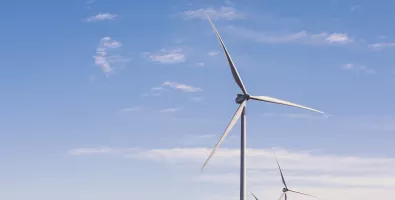
The last WindFloat platform is on its way to Viana do Castelo
Project WindFloat Atlantic completes another decisive stage this Thursday morning (May 28) with the departure of the third and last platform from Ferrol Port to the coast of Viana do Castelo. The wind tower will take three days to reach its destination, 20 kilometers off the Portuguese coast, where the first floating offshore wind farm in continental Europe is being built.
The operation will be completed when this final platform is fixed to the mooring system created in that ocean area and connected to the existing structures in the offshore wind farm. The other two turbines - installed in October and December 2019 - are already operating and connected to Portugal's national grid, which they will supply with clean energy.
With an installed capacity of 25 MW, the wind farm will be able to generate enough energy to supply 60,000 families per year. Its structure - 30 meters high and with a 50-meter distance between each column fixed onto the platforms - boasts the world's largest wind turbines on a floating surface, each with a production capacity of 8.4 MW.
The three floating platforms are the result of an Iberian cooperation effort: two of them were built in Setúbal (Portugal) and the third in Avilés and Ferrol (Spain). The project uses an innovative technology called WindFloat, which allows the three platforms to be anchored at a depth of 100 meters, thus minimizing the structure's environmental impact and facilitating access to wind resources without exploring deep waters.
This technology offers many other advantages, including the fact that the turbines are assembled on land, that it is not necessary to use a specific transport vessel for their towing, and that they do not depend on the complex offshore operations associated with the installation of traditional fixed structures. All these factors contribute to reducing the risks and expenses associated with the project's life cycle.
A project marked by innovation
The project is headed by the Windplus consortium, consisting of EDP Renováveis (54.4%), Engie (25%), Repsol (19.4%) and Principle Power Inc. (1.2%). Project WindFloat Atlantic was made possible due to the success of the WindFloat1 prototype, which operated from 2011 to 2016. This 2 MW pilot project successfully produced energy over five years with no interruptions and survived extreme weather conditions unscathed, including waves of up to 17 meters high and 60-knot winds.
The initiative was sponsored by public and private institutions, encouraging leading companies in their respective markets to join the project, and received funds from the Portuguese Government, the European Commission, and the European Investment Bank. Project partners include Principle Power, the joint venture between Navantia/Windar, Grupo A. Silva Matos, Bourbon, wind turbine supplier MHI Vestas, and dynamic cable supplier JDR Cables.
Windfloat Atlantic is a landmark in the sector, as it is the world's first semi-submersible floating wind farm. Due to its innovative features and the access it provides to energy resources in large maritime areas, this project meets several important challenges - such as clean energy transition, energy security, and climate change - while also contributing to job creation, economical growth, and sustainable investment opportunities.


